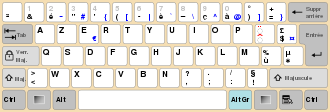to mark long vowels. The acute accent was first used in French in 1530 by Geoffroy Tory, the royal printer. The acute accent was first used in the polytonic...
39 KB (4,853 words) - 12:34, 10 March 2025
The double acute accent (◌̋) is a diacritic mark of the Latin and Cyrillic scripts. It is used primarily in Hungarian or Chuvash, and consequently it is...
10 KB (871 words) - 12:41, 18 February 2025
Diacritic (redirect from Accent mark)
Some diacritics, such as the acute ⟨ó⟩, grave ⟨ò⟩, and circumflex ⟨ô⟩ (all shown above an 'o'), are often called accents. Diacritics may appear above...
105 KB (8,906 words) - 10:30, 24 April 2025
syllable as the pitch accent in ancient Greek. The ancient Greek grammarians indicated the word-accent with three diacritic signs: the acute (ά), the circumflex...
151 KB (15,015 words) - 15:52, 21 March 2025
Stress (linguistics) (redirect from Phenomenal accent)
all polysyllables are written with an acute accent (´) over the vowel of the stressed syllable. (The acute accent is also used on some monosyllables in...
38 KB (4,720 words) - 20:27, 9 March 2025
Greek diacritics (redirect from Grave accent rule)
(tónos) 'accent') is the standard system for Ancient Greek and Medieval Greek and includes: acute accent (´) circumflex accent (῀) grave accent (`); these...
33 KB (2,700 words) - 19:53, 22 April 2025
The grave accent first appeared in the polytonic orthography of Ancient Greek to mark a lower pitch than the high pitch of the acute accent. In modern...
19 KB (2,137 words) - 17:17, 24 April 2025
Circumflex (redirect from Circumflex accent)
acute and grave accents (^), as it marked a syllable contracted from two vowels: an acute-accented vowel and a non-accented vowel (all non-accented syllables...
35 KB (3,824 words) - 20:06, 9 April 2025
Swedish phonology (redirect from Swedish accent)
tones, often described as pitch accents, or tonal word accents. They are called acute and grave accent, accent 1 and accent 2. The actual realization of...
64 KB (5,695 words) - 19:31, 12 March 2025
Proto-Balto-Slavic language (redirect from Balto-Slavic acute)
ˀ will be used in this article. In Proto-Balto-Slavic, the acute was independent of accent position, and could appear on any "long" syllable, which included:...
100 KB (11,151 words) - 23:03, 27 March 2025
Dutch orthography (section Acute accent)
written as a digraph, an acute accent is put on both parts of the digraph. Although that rule includes ⟨ij⟩, the acute accent on the ⟨j⟩ is frequently omitted...
44 KB (4,098 words) - 08:41, 19 February 2025
AZERTY (section Acute accent)
the acute accent is generated by a combination of the Alt+⇧+&, keys, followed by the vowel. In the Belgian AZERTY layout, a vowel with an acute accent can...
30 KB (3,658 words) - 09:51, 11 April 2025
Proto-Slavic language (section Pitch accent)
standard notation in Serbo-Croatian: Acute accent ⟨á⟩: A long rising accent, originating from the Balto-Slavic "acute" accent. This occurred in the Middle Common...
80 KB (7,647 words) - 12:34, 21 April 2025
QWERTY (redirect from QWERTY and accents)
in which case the AltGr+' method must be used to generate acute accents. The acute accent in Irish is additionally provided using AltGr+vowel. US 79868...
99 KB (10,651 words) - 15:42, 14 April 2025
U+02C8 ˈ MODIFIER LETTER VERTICAL LINE Stress accent or dynamic accent. U+02CA ˊ MODIFIER LETTER ACUTE ACCENT U+02EE ˮ MODIFIER LETTER DOUBLE APOSTROPHE...
142 KB (16,483 words) - 09:40, 24 April 2025
Lithuanian accentuation (redirect from Lithuanian accent)
one of two prosodically distinct ways. One way is known as the acute or falling accent: this may be described as "sudden, sharp or rough". In Lithuanian...
49 KB (4,531 words) - 16:03, 14 March 2025
Backtick (redirect from Freestanding grave accent)
open and close quotes while still being somewhat usable as grave and acute accents, made apostrophes typographically correct, and allowed the apostrophe...
16 KB (1,894 words) - 00:57, 28 March 2025
the acute accent, with multiple foundation characters (such as á, é, í, ó, ú) the decision was made to create a new character, the acute accent or diacritic...
11 KB (1,436 words) - 22:46, 8 March 2025
There are two kinds of tonal accent, referred to as the acute and grave accents, but they are also called accent 1 and accent 2 or tone 1 and tone 2. Over...
93 KB (11,581 words) - 04:53, 1 April 2025
based on the Latin alphabet and makes use of the acute accent, the circumflex accent, the grave accent, the tilde, and the cedilla to denote stress, vowel...
61 KB (6,132 words) - 20:28, 17 March 2025
Latin, the apex (plural "apices") is a mark with roughly the shape of an acute accent (´) or apostrophe (ʼ) that was sometimes placed over vowels to indicate...
9 KB (1,109 words) - 08:49, 18 April 2025
could bear a suprasegmental feature known as acute. The acute feature could occur independently of the accent, and Slavic retained this situation until at...
60 KB (6,258 words) - 15:51, 19 April 2025
the polytonic orthography and modern Greek keeping only the stress accent (acute) and the diaeresis. Apart from its use in writing the Greek language...
116 KB (9,044 words) - 02:38, 16 April 2025
compulsory diacritics, but allows the use of an acute accent (accent aigu) for disambiguation. Most often, an accent on ⟨e⟩ marks a stressed syllable in one of...
15 KB (1,510 words) - 02:24, 18 April 2025











